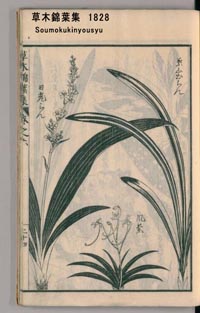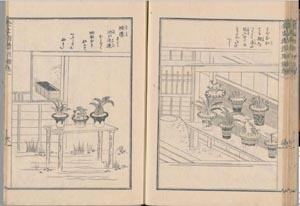A short history of the Fuukiran
What is Fuukiran?
The 12th World Orchid Conference, a global event occurring every three years, was held in Japan in 1987. At that time, a flower of Neofinetia falcata was chosen as the symbol to represent Japanese wild orchids. Because of this, Neofinetia falcata was recognized widely among orchid enthusiasts and other plant lovers. Fuukiran means in general, a mutated or variegated Neofinetia falcata collected from the wild.
In Japanese traditional gardening, an elegant name is used to denote a valuable plant. This is true also for Rhodea japonica, Dendrobium moniliforme and Ardisia crispa. However, even if a Neofinetia falcate has variagation, it is recognized as a Fuukiran only after being registered with Japan Fuukiran Society. For instance, if a variagation of Neofinetia falcata is newly discovered, it is still just a variety of Neofinetia falcata and cannot be defined as a Fuukiran. To be a new Fuukiran , (1) the same variation must continue consistently for years, (2) the number of plants must increase to some extent, and (3) the physical characters should be clearly different from other recognized variety. After applying for registration with the Japan Fuukiran Society and receiving judgment, it is recognized as a new Fuukiran. (Talk here about the 3 plants, and the fees etc. Readers will be interested in this.)


The beginning of Fuukiran
The history of Fuukiran goes back to the gardening culture of the Edo Era (1603-1867). In the middle of the Edo Era, around the Bunka and Bunsei period (1804-1830) people were enjoying a peaceful life, and collecting unusual trees and plants was very popular, just like we are enjoying now. Some publications introducing new plant varieties increased in popularity, too. We can find wood block prints in “草木金葉集 Soumokukinyousyu” (1828) of Neofinetia falcata with the messages “Someone living in Iga District found variegated Neofinetia but failed to grow it” We can imagine how enthusiastic this news was welcomed at that time from the fact that records of Neofinetia falcate found in a local district were widely known around Edo, the capital of the Edo era. In addition, plant collecting became a way of moneymaking in the same manner as we make our current equity investments. For example, a book titled " 金生樹譜 Kinseijyuhu ( A picture book of plants which bring you money)"(1856) shows us how there were many plant lovers eager to make money from from their collections. One bud of Rhodea japonica or Ardisia crispa was equivalent to 100-200 Ryo of gold in those days. A variegated Neofinetia falcata seems to have been equivalent in price to a single-family home with a garden. Omoto (Rhodea japonica), 長生蘭Choseiran (Dendrobium moniliforme) and Fuukiran (Neofinetia falcata) were seen as plants for moneymaking and had enthusiastic dedicated societies in different cities, much like we have now. The Eleventh Tokugawa shogun was an enthusiastic fan of Fuukiran. Fuukiran were gathered in Edo-jo Castle and covered with a gold or silver net for protection. When people were allowed to look closely, they were required to hold paper to their mouths to prevent breathing on the plant, much the same as is observed in the appreciation of a sword.
Because of their value, many feudal lords serving the Shogun eagerly looked for variegated plants of Neofinetia falcata in their territory and presented them to the Shogun.
In Edo-jo Castle of that time, we can imagine the following conversation:
Lord A:
「A splendid Fuukiran was found in our feudal land, so I presented it to the general. He was pleased to have it very much.”
Lord B:“
「No way! Our gift of a Fuukiran is far superior and definitely the general’s favorite.”
Each feudal lord did his best in the cultivation of Fuukiran and enjoyed flowers and fragrance hanging in their vehicle when they traveled. The trend gradually spread to high class society, and Fuukiran societies were established in each region. Eventually, a directory and ranking of Fuukiran, similar to the ranking directory of sumo wrestlers, was published, and the term “ Fuukiran” meaning “Orchids loved by rich and noble people” was coined. This was the first boom in Fuukiran growing. But a member of the Shogun's Council of Elders, Tadakuni Mizuno, carried out Reform of the Tempo Era including sumptuary laws forbidding luxury in 1841 which cooled the fever for economy and also Fuukiran. The disturbance during last days of the Tokugawa government to Meiji Restoration in 1868, confusion made the people unable to afford to be able to enjoy Fuukiran.
The Meiji Era to before World War II
In the Meiji era (1868- ) the new government introduced European and American culture in a positive light. Similarly in the world of gardening, either gorgeous and showy orchids from foreign countries were praised by polite society. Fuukiran were no longer the center of a gardening world. However, while Fuukiran diminished in popularity, they were inherited and maintained by a handful of earnest lovers.
Around 1877-1882 the ranking board of Fuukiran began publishing their lists again, as they had in the past, and this situation continued until the beginning of the Showa Era (1926).
Meanwhile, though Fuukiran were unpopular and valueless to most Japanese, still there were enthusiastic hobbyists who continued cultivating quietly. Even if the public’s opinion changed, Fuukiran never changed. They were handed down by true lovers. But as the Showa Era began, so began the second boom of Fuukiran collection, and it continued until the end of 1943, when World War II began. The Oriental orchid became a hit at the beginning of the Showa era because of the feeling in Japanese society inclined toward Western culture.
Around 1935, the fact that Fuukiran appeared in many publications proves that popularity had increased on a nationwide scale. In 1930, the Tokyo Fuukiran society was founded, and after that, the Fuukiran ranking was published again, and Fuukiran societies were born in various places. In 1939, these smaller societies merged to form the Japan Fuukiran Federation. At that time the price of Fuukiran was so expensive that an announcement party was held when someone purchased a good Fuukiran. Due to the cost, collecting was limited to people like aristocrats, doctors and other upper class figures. It was a world not available to ordinary people. The high cost of Fuukiran combined with the expansion of the War gradually made Fuukiran collection nearly impossible.
After World War II down to the present
After World War II there were small meetings in many places. In 1947, a Fuukiran exhibition sponsored by The Japan Fuukiran Society was held in Nagoya. It was the first exhibition of Fuukiran after the W.W. II. After that, an inactive period again continued. Then in 1970, Sinji Sumiya (Oosaka) and Bakuzan Sakaki (Sho-do artist) published a book privately titled “Fuukiran”, which lamented the loss of popularity of Fuukiran over the previous 20 years.
In 1973 The Japan Fuukiran Society and Kinki Fuukiran Society cooperated with Japan Choseiran Federation to hold an Artistic Fuuran Exhibition, the biggest since WW II, at Chausuyama-honjin restaurant in Oosaka. There, 200 Fuukiran collectors gathered to show hundreds of their beloved plants from all over Japan. Since then, the population of Fuukiran lovers has increased gradually.
We really appreciate the effort of old Fuukiran lovers to protect their plants from the difficulties of war and to maintain those historically valuable and rare Fuukirans. We also appreciate the contributions of many people who wrote articles about Fuukiran for gardening journals which helped make Fuukiran a popular hobby again.
Recently the number of varieties of plants has increased and they are easily obtainable by mail order. It was once said, that Fuukiran is only a Samurai’s hobby, but now it is a hobby for everyone. Fuukiran is very tiny plant. It is perfect for urban life because you can grow various types even in small space. I really hope the old and new characters of Fuukiran will bring us more new-comers in the near future and create the greatest Fuukiran boom we ever had.

